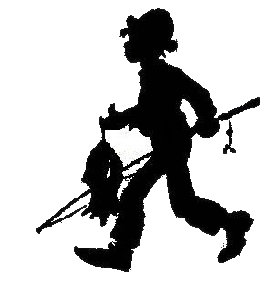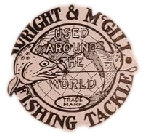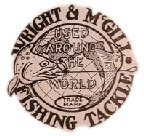

















Nature Faker Fly
c. 1930-35
Generally confused with the Fly Moth, Nature Faker are much longer having many more segmentations along the body. The introductory versions had black heads, two colored eyes and accented abdominal segments with contrasting color. Version two usually reflects the head and thorax of the same color, with version three having delineated body configurations by use of two narrow bands of thread. Rare
Flying Moth
c. 1935-38
Often confused as being a Nature Faker, their bodies are significantly shorter. Most reflect two body segments characterized by two narrow bands of thread. Can be found with or with a black head, but all have tiny colored bead eyes. Wings are attached at a single point delineating the head from the abdomen. Common.
Polly-Wog or Tad-Pole
c. 1930-31
Apparently designed to mimic the larval stage of a frog, these flies feature a split flexible rubber
tail, set in an enameled wood body with black bead eyes. This lure is considered very rare to find.


This is a pretty nice historical addition for a number of reasons. It appears these were part of a
Montgomery Ward delivery so if anyone comes across any Mont. Ward literature referencing, I would appreciate a copy.
The card
with examples dates to 1941 /42 and contains some baits I never expected to see, even in the shape these are in. These are the
first baits offered in Wright McGill’s material call Plyex, a flexible, pliable plastic molded in molds made from live models.
Shown on the card is grasshopper, caddis worm, stone creeper, frog, hellgrammite, and cricket. Rare
Nature Lure (A Natural Fly or Grasshopper)
The carded Nature Lures look very similar to " A Natural Fly" and could be one in the same. What is interesting here beyond the flies themselves is the card printing. This is only example I can recall depicting water waves. The green font and bordering is very unique, but the water waves are uncharacteristic of Wright McGill. And to boot the waves are not stamping but actual printing components of the card stock. We have confirmed that the card stock shown is a perfect match to that which Wright McGill used. So chalk up another mystery to Wright McGill and another piece to the puzzle. Rare
Helgamite
Only found in 1930 literature, the Helgamite was cataloged in two sizes, large and small. This example is the small version. The color of this bait is a brown olive, though a green version in the large size is known. The belly view shows what is left of the rubber appendages that would have emanated from both sides. Very few examples are known. Rare
Wrimac Feather Minnow
Designed to represent small baitfish the Wrimac Feather Minnow were made of colored chenille bodies with chenille heads usually black and large glass eyes. Came in 5 sizes. Very scarce to rare.
Dragon Fly
Only listed available in 1930, this glass eyed cast cork body featured a long segmented cork body accented with contrasting color detailing. Has hackle feather wings and strands of ostrich hurl tied in behind the head. This example unfortunately has had the hook point cliped for some reason. Very rare.
Cork Center Bass & Crappie Bug
Cork bodies wrapped with silk, wool or chenille depending upon the pattern Examples with tinsel wrapped floss or wool covered bodies ae more difficult to locate. Most have their hair wings oriented at right angles to the body, however some are found with the wings tied back.